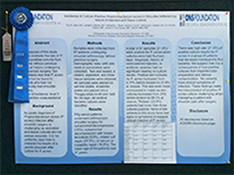Home > Research > Biomechanical and Clinical Research Studies > Understanding and Minimizing the Risk for Infection
Understanding and Minimizing the Risk for Infection
As the field of shoulder surgery, particularly shoulder replacement, grows, the risk of developing shoulder infection increases. Infection, when treated imperfectly, may be a devastating complication. Our goal was to help develop a universal measure to absolutely minimize post-surgical infection. The bacterium
(Proprionibacterium Acnes) that is most commonly attributed to shoulder infection is a very unusual organism; until recently, it was not properly recognized because it was so difficult to identify. Now that one of the greatest bacterial offenders (in the shoulder) has been more clearly identified, we continue to look for ways to prevent it from infecting patients. In our last study, we took over three hundred cultures and studied them. After careful analysis, we were able to identify when (during surgery) patients are most susceptible to this bacterial infection and were able to determine just how frequently this bacteria is present. Now that we know when this bacterium may gain its access to patients, we are developing ways to attack the bacteria at the patient’s point of vulnerability.
At the American Orthopedic Society for Sports Medicine (AOSSM) in Seattle, WA, ONSF won 2nd place as an outstanding poster. This first study has been accepted for publication in The Journal of Shoulder and Elbow Surgeons. In addition, our second study examining alternative skin preparation used to reduce the bacteria identified in our first study is well underway.
< Back to Biomechanical Research Studies List








